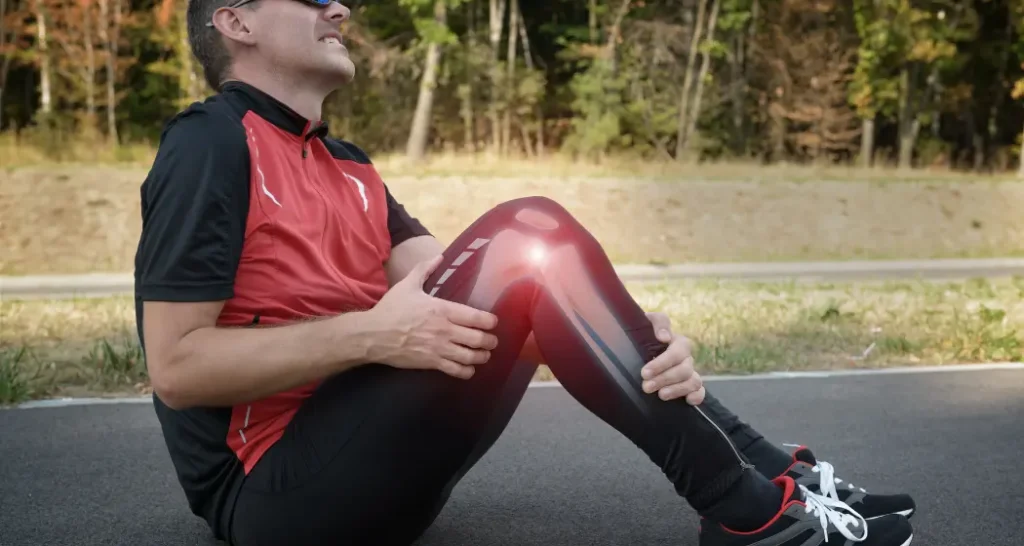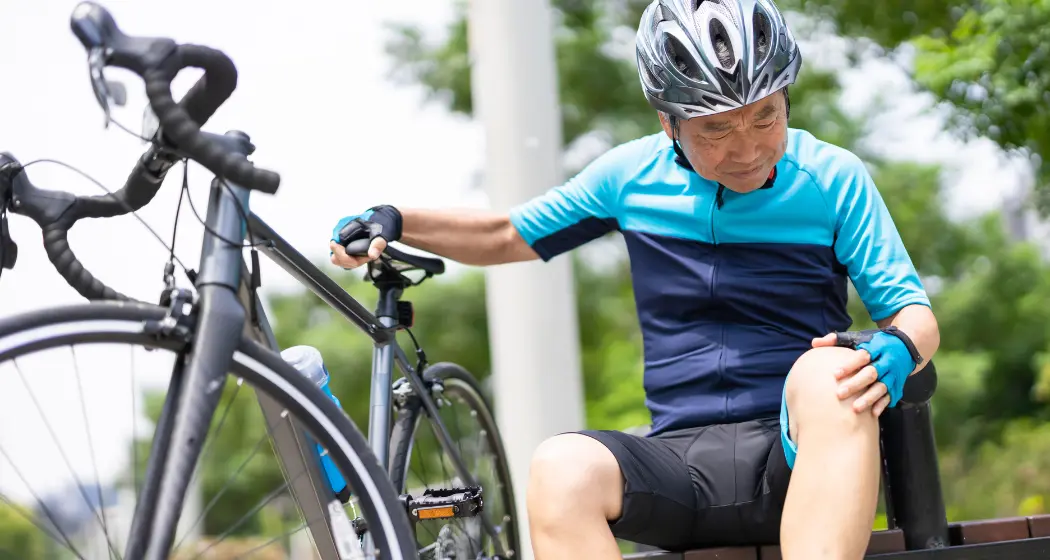Cycling knee pain associated with Osteoarthritis of the Knee (OA), also known as degenerative joint disease, is typically the result of wear and tear and progressive loss of articular and meniscal cartilage. This break down of the cartilage causes the bones of the knee joint to rub together, causing friction which then causes pain, inflammation, stiffness, tenderness, loss of flexibility and range of motion followed by a grating sensation, bones spurs and increased discomfort.
Activity is very important for overall health, but also for increasing synovial fluid within the joint. However impact activity can cause severe discomfort into an arthritic knee, thus Lowe impact activities such as cycling are extremely beneficial. Cycling for osteoarthritis of the knee can be done indoors at home or at a gym. If you are afraid of falling, have no where to ride outside, or if the weather is bad, cycling is great indoors, however is you have a chance to cycle outdoors that is also a great alternative.
Benefits of Cycling for Osteoarthritis of the Knee
There are multiple benefits of cycling for Osteoarthritis of the knee, including an increase in what we call happy hormones or endorphins. These hormones are produced in the brain and they make us happy. These endorphins cause an increase in mood, and help relieve pain and discomfort.
Cycling for Osteoarthritis of the knee is also great for weight control. Excess weight can put an increase of pressure onto the osteoarthritic knee. Thus for every pound that you are overweight it increases the amount of pressure on that osteoarthritic knee by 4 pounds. So image being 20 pounds over weight, that is over 80 pounds of pressure on that osteoarthritic knee joint.
Also, cycling helps increase muscle mass and strengthens leg muscles as well as improving flexibility and range of motion. This is incredibly important for stabilizing a weak joint that has osteoarthritis. Plus the pedaling action helps increase synovial fluid, which lubricates the joint and also helps with flexibility. Overall cycling for osteoarthritis of the knee is great for improving overall health. Cycling is an aerobic activity, thus strengthening the heart, lungs, and blood vessels.
Other areas where we see an improvement from cycling for osteoarthritis of the knee is improving overall balance and coordination. While cycling your core, which includes all the muscles of your torso, need to work together to stabilize your body on the bike, preventing you from falling off. The lower and upper body also have to work together, this harmony and coordination helps improve your overall balance.
Key things to make sure are correct to prevent pain with Cycling osteoarthritis of the knee
Cycling knee pain associated with osteoarthritis often occurs at the patellofemoral joint. This joint is situated beneath the knee cap, connecting with the femur or thigh bone. That pain usually begins as a dull ache, that then increases with longer distances. Thus if you are already experiencing osteoarthritis of the knee, you need to pay attention to when your knee pain is increasing while riding. Cycling’s challenge lies in its low load on the knee joint, allowing extended activity. However, this can become a double-edged blessing and curse as knee tissues may react over time.
Thus it is very important to pay attention to your body as you are cycling. Some people who cycle for knee osteoarthritis are able to find a distinct point when they are riding, where they start feeling more discomfort. This is the point where you should stop and not push further. Osteoarthritis feels relief with some exercise, however overdoing it will increase the discomfort. That is why is important to pay attention to your body, manage our pain, but also nail down the cause. Here are a few most common causes of cycling for Osteoarthritis of the knee.

Saddle or Seat Height
When you’re dealing with knee pain, one of the first things to look at is your saddle height, says Dr. Vida Puodziunas of Waters Edge Medical Clinic and Spa. You want to make sure that there is a slight bend in the knee at the bottom of the pedal stroke. In other words put your foot onto the pedal and push the heel down, to 6 o’clock position. You should have a slight bend in the knee about 25 to 35 degrees of knee flexion. You should be able to almost fully straighten out your leg, while on the pedal, without lifting or tilting your pelvis.
Footwear
Your knee pain could also be caused either by your shoes or your foot position itself. Make sure that you have a professional evaluate your foot or cleat position if your are using clipless pedals. You can also try adjusting our own feet and cleats to see if a change in position decreases pain and discomfort. “If you have the cleat position wrong, then it throws everything else off up the [kinetic] chain.” (Peliton)
A lack of arch support can also contribute to knee pain, Particularly if you have flat feet, causing the knee to fall inward, or become a knock kneed. This position puts undue stress and strain on ligaments and the medial aspect of the knee joint. Purchasing some over the counter arch supports would be beneficial.
Making sure not to Overtrain or overexert
Cycling for Osteoarthritis of the knee is extremely beneficial, however as mentioned before overexerting or overtraining can lead to pain and discomfort. Thus it is extremely important to pay attention to volume, intensity and even the combination of both. If you are consistently completing high-intensity workouts or cycling too far, too long and too hard without adequate recovery in between sessions, you may be setting yourself up for increased osteoarthritis of the knee. It is vital in-between cycling session to stretch, recover and rest.
Cycling for Osteoarthritis of the knee is extremely beneficial, however as mentioned before overexerting or overtraining can lead to Cycling knee pain and discomfort. Thus it is extremely important to pay attention to volume, intensity and even the combination of both. If you are consistently completing high-intensity workouts or cycling too far, too long and too hard without adequate recovery in between sessions, you may be setting yourself up for increased osteoarthritis of the knee. It is vital in-between cycling session to stretch, recover and rest.
Best steps to Manage Cycling knee pain due to Osteoarthritis
- Ice the affected area and end with a little heat: Ice is great for alleviating Cycling knee pain, especially after a bike ride, so place ice on top of the knee and underneath the knee. This will allow swelling to decrease and is a nice natural pain reliever, you can also apply a cooling gel like Icy hot, or bio freeze to help drive the cold in deeper. Ice no longer than 20 minutes, end off with a little moist heat for about 2 to 3 minutes, this prevents stiffening of the joint.
- Be strategic with your pain medication: Don’t take non-steroidal anti-inflammatory drugs (NSAIDs) like ibuprofen, unless you really need them for managing Cycling knee pain. They’re designed to reduce inflammation—but the inflammation response promotes healing. That is why it is best to wait at least 48 hours from the onset of pain. Also, natural products like Boswelia or Turmeric are natural anti-inflammatories and do not cause severe side effects like NSAIDs.
- Use compression: Compression is a great pain relief technique for managing cycling knee pain. Using ice provides pain relief by numbing the area, compression actually addresses the root cause of the pain—the swelling that’s creating tension within the joint space. An Ace bandage or a compression sleeve can be used, and these items can be found on Amazon, or at your local pharmacy.
Sometimes you need more than the above conservative solution to manage the pain. By visiting Waters Edge Medical Clinic, we can assess and address your concern. Our dedicated team offers solutions and potential regeneration for the affected area. Thus if your pain is greater than a five out of ten and persists longer than 24 hours, schedule a free consultation with us.

